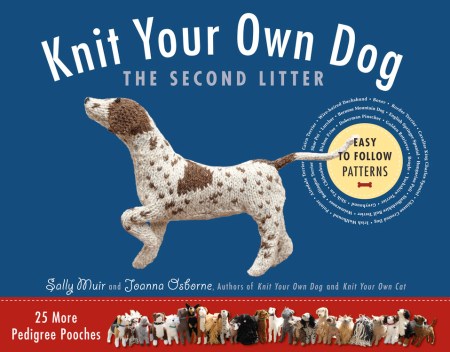As knitting becomes increasingly popular, it has branched beyond garments and blankets. Knitting toys and oddities, such as Japanese-style amigurumi?small and whimsical knit or crocheted people and objects?is on the rise. Combine that trend with the number of people who both own and love dogs, and Knit Your Own Dog: The Second Litter finds its niche.Sally Muir and Joanna Osborne's second installment of Knit Your Own Dog offers knitters twenty-five more patterns for common dog breeds. The book builds on the author's first volume, released in 2011, and adds to their expanding catalog, which also includes Knit Your Own Cat, released in 2012. The dog breeds featured here are categorized following familiar dog club standards: toy, utility, terriers, sporting, and working. Among the featured breeds are common favorites, like golden retrievers and beagles, as well as more unique dogs, like the Chinese crested dog and Bedlington terrier.Each pattern includes a broad picture of the finished knitted toy and a brief history of the breed before moving into pattern details and up-close pictures. The patterns cover measurements, materials, each section of the dog, and finishing construction. All common knitting directions are utilized. The patterns are clear and easy to follow, though too advanced for a beginning knitter. Knitting instructions are included at the back of the book, but they serve mostly as reminders for experienced knitters, not guides for learning. Also included at the volume's end are hints and tips for sewing all parts of the toys together.Other than the brief descriptions of the breeds at the introduction of each pattern, little other narrative is featured. This book is meant to be utilized for the patterns, not necessarily read for pleasure. That said, the layout is beautiful, and the full-color pictures of each completed toy are rich and detailed. It has the look and feel of a book that could be set out to be flipped through when not being used to make the toys.Although standard dog breeds are featured in the patterns, much of the book covers the variety of ways the dogs can be customized. The author's suggest using larger needles and yarn for full-sized toys or adjusting colors, leg length, and hair styles to create more unique creations. Most patterns include ideas specific to that breed, such as how to add more wrinkles to the Shar Pei or changing markings on the Bernese Mountain Dog. In the end, the volume offers more than just the twenty-five dogs featured.The products of these patterns can be used in many different ways. The authors point out the options, such as gifts for children and dog lovers or a reminder of a lost pet. The resulting toys are sure to be welcomed by all kinds of dog lovers and knitters alike.
